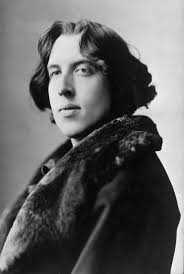The Picture of Dorian Gray Page #41
The Picture of Dorian Gray is a Gothic and philosophical novel by Oscar Wilde, first published complete in the July 1890 issue of Lippincott's Monthly Magazine. Fearing the story was indecent, prior to publication the magazine's editor deleted roughly five hundred words without Wilde's knowledge.
Yet one had ancestors in literature as well as in one's own race, nearer perhaps in type and temperament, many of them, and certainly with an influence of which one was more absolutely conscious. There were times when it appeared to Dorian Gray that the whole of history was merely the record of his own life, not as he had lived it in act and circumstance, but as his imagination had created it for him, as it had been in his brain and in his passions. He felt that he had known them all, those strange terrible figures that had passed across the stage of the world and made sin so marvellous and evil so full of subtlety. It seemed to him that in some mysterious way their lives had been his own. The hero of the wonderful novel that had so influenced his life had himself known this curious fancy. In the seventh chapter he tells how, crowned with laurel, lest lightning might strike him, he had sat, as Tiberius, in a garden at Capri, reading the shameful books of Elephantis, while dwarfs and peacocks strutted round him and the flute-player mocked the swinger of the censer; and, as Caligula, had caroused with the green-shirted jockeys in their stables and supped in an ivory manger with a jewel-frontleted horse; and, as Domitian, had wandered through a corridor lined with marble mirrors, looking round with haggard eyes for the reflection of the dagger that was to end his days, and sick with that ennui, that terrible taedium vitae, that comes on those to whom life denies nothing; and had peered through a clear emerald at the red shambles of the circus and then, in a litter of pearl and purple drawn by silver-shod mules, been carried through the Street of Pomegranates to a House of Gold and heard men cry on Nero Caesar as he passed by; and, as Elagabalus, had painted his face with colours, and plied the distaff among the women, and brought the Moon from Carthage and given her in mystic marriage to the Sun. Over and over again Dorian used to read this fantastic chapter, and the two chapters immediately following, in which, as in some curious tapestries or cunningly wrought enamels, were pictured the awful and beautiful forms of those whom vice and blood and weariness had made monstrous or mad: Filippo, Duke of Milan, who slew his wife and painted her lips with a scarlet poison that her lover might suck death from the dead thing he fondled; Pietro Barbi, the Venetian, known as Paul the Second, who sought in his vanity to assume the title of Formosus, and whose tiara, valued at two hundred thousand florins, was bought at the price of a terrible sin; Gian Maria Visconti, who used hounds to chase living men and whose murdered body was covered with roses by a harlot who had loved him; the Borgia on his white horse, with Fratricide riding beside him and his mantle stained with the blood of Perotto; Pietro Riario, the young Cardinal Archbishop of Florence, child and minion of Sixtus IV, whose beauty was equalled only by his debauchery, and who received Leonora of Aragon in a pavilion of white and crimson silk, filled with nymphs and centaurs, and gilded a boy that he might serve at the feast as Ganymede or Hylas; Ezzelin, whose melancholy could be cured only by the spectacle of death, and who had a passion for red blood, as other men have for red wine--the son of the Fiend, as was reported, and one who had cheated his father at dice when gambling with him for his own soul; Giambattista Cibo, who in mockery took the name of Innocent and into whose torpid veins the blood of three lads was infused by a Jewish doctor; Sigismondo Malatesta, the lover of Isotta and the lord of Rimini, whose effigy was burned at Rome as the enemy of God and man, who strangled Polyssena with a napkin, and gave poison to Ginevra d'Este in a cup of emerald, and in honour of a shameful passion built a pagan church for Christian worship; Charles VI, who had so wildly adored his brother's wife that a leper had warned him of the insanity that was coming on him, and who, when his brain had sickened and grown strange, could only be soothed by Saracen cards painted with the images of love and death and madness; and, in his trimmed jerkin and jewelled cap and acanthuslike curls, Grifonetto Baglioni, who slew Astorre with his bride, and Simonetto with his page, and whose comeliness was such that, as he lay dying in the yellow piazza of Perugia, those who had hated him could not choose but weep, and Atalanta, who had cursed him, blessed him.
Translation
Translate and read this book in other languages:
Select another language:
- - Select -
- 简体中文 (Chinese - Simplified)
- 繁體中文 (Chinese - Traditional)
- Español (Spanish)
- Esperanto (Esperanto)
- 日本語 (Japanese)
- Português (Portuguese)
- Deutsch (German)
- العربية (Arabic)
- Français (French)
- Русский (Russian)
- ಕನ್ನಡ (Kannada)
- 한국어 (Korean)
- עברית (Hebrew)
- Gaeilge (Irish)
- Українська (Ukrainian)
- اردو (Urdu)
- Magyar (Hungarian)
- मानक हिन्दी (Hindi)
- Indonesia (Indonesian)
- Italiano (Italian)
- தமிழ் (Tamil)
- Türkçe (Turkish)
- తెలుగు (Telugu)
- ภาษาไทย (Thai)
- Tiếng Việt (Vietnamese)
- Čeština (Czech)
- Polski (Polish)
- Bahasa Indonesia (Indonesian)
- Românește (Romanian)
- Nederlands (Dutch)
- Ελληνικά (Greek)
- Latinum (Latin)
- Svenska (Swedish)
- Dansk (Danish)
- Suomi (Finnish)
- فارسی (Persian)
- ייִדיש (Yiddish)
- հայերեն (Armenian)
- Norsk (Norwegian)
- English (English)
Citation
Use the citation below to add this book to your bibliography:
Style:MLAChicagoAPA
"The Picture of Dorian Gray Books." Literature.com. STANDS4 LLC, 2024. Web. 27 Nov. 2024. <https://www.literature.com/book/the_picture_of_dorian_gray_869>.




Discuss this The Picture of Dorian Gray book with the community:
Report Comment
We're doing our best to make sure our content is useful, accurate and safe.
If by any chance you spot an inappropriate comment while navigating through our website please use this form to let us know, and we'll take care of it shortly.
Attachment
You need to be logged in to favorite.
Log In